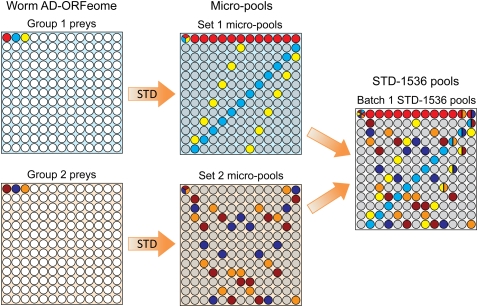Figure 2.
STD pooling design used in this paper. Worm AD-ORFeome preys (12,675) were split into 75 groups, each containing 169 preys. Each group was STD-pooled into a set of 169 micropools. Each micropool contains 13 preys (micropool size: 13), and each prey is contained in a unique combination of 13 micropools (a unique signature; redundancy: 13), as illustrated with three color-coded preys in sets 1 or 2. Two preys co-occur in at most one micropool, so that each prey is uniquely identified by any two of the 13 pools that contain it; therefore, these micropool designs have an extra redundancy of 11. In addition, the micropool signatures of preys with identical AD-ORFeome coordinates from groups 1 and 2 are very different (e.g., light red in set 1 and dark red in set 2): Every two sets of micropools can be superposed to obtain one batch of STD-1536 pools, such that two preys from different groups co-occur in at most two common pools. Consequently, in STD-1536 each prey is uniquely identified by any three of the 13 pools that contain it: STD-1536 pools possess an extra redundancy of 10.

